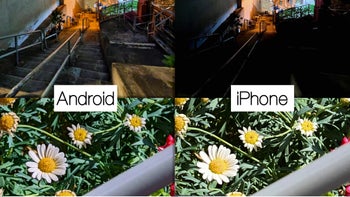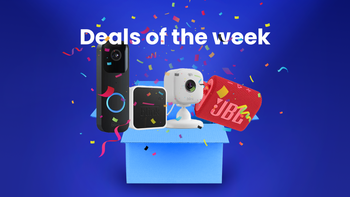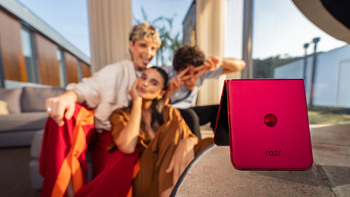iPhone 14's camera might lose to Pixel 7 in photo quality, shows wonky iPhone 13 camera performance
This article may contain personal views and opinion from the author.

So, I recently got my hands on an iPhone 13, which I've been using for a few weeks now, and I can't help but notice that Apple's phone... falls behind the competition in the area of photography. Sometimes… way behind.
To the first point, the iPhone's popularity as a camera comes together with the smartphone revolution itself, but also because Apple makes just four iPhone models a year, with only two camera systems shared amongst them. And of course, the iPhone simply sells better than any other Android flagship in the world and even more than many budget phones.
And then when it comes to "keeping it natural", iPhones used to be known to have the "most realistic" smartphone camera with natural colors, balanced sharpness, and very high dynamic range (HDR). However, as it turns out, that might not be the case anymore. Or at least compared to the competition.
So, let's talk about the iPhone's problems in the area of photography and see if there's a chance that iPhone 14 will bring Apple back to its glory days in this are of the user experience, which is now more important to customers than ever.
Starting with something quite obvious but still worth mentioning, I can't avoid discussing the relative lack of detail in the iPhone 13's photos, compared to the Pixel 6 Pro’s, which is the main phone I'll be using for this comparison.
The other area where iPhone 13 struggles is with colors, white balance, and human tones, but let's take it step by step…
If you're like me, you'd remember the "glory days" of the iPhone camera, when Apple's device took the most accurate and natural photos. However, Cupertino had to give in to the demand for "Instagram-ready photos", and it shows.
Ever since the iPhone 11, and especially iPhone 12 and 13 series, Apple's been dragging the saturation slider a bit too courageously for my liking, and almost to a point where photos taken with a Galaxy might turn out to look more realistic than the iPhone's. That's quite ironic because it used to be the other way around five years ago. For the record, iPhone XS was probably the last iPhone that carried Apple's priority for natural images at its core.
But that's not all…
Apart from the overly excessive saturation, there's a noticeable yellowish tint to Apple's default image processing, which might appeal to some. You could argue it makes certain images livelier, but it also happens to make them undeniably less accurate to the scene, and that's not very "pro".
But this quickly becomes very bizarre when you discover that the iPhone 13 can also overly exaggerate blue highlights, causing walls, buildings, and even people's faces to look… blue. It happens when the scene features a blue light or a bright blue sky, and it seems to be part of Apple's Smart HDR4 feature, which ironically aims to make your photos more balanced…
And finally, speaking of people and faces, I can't skip mentioning the iPhone's tendency to make people look somewhat red/orange - and that's when it doesn't make them look blue… It's noticeable on every skin tone but especially in photos that feature people with a darker complexion, which turn orange (lighter skin tones can look red, as if the person has a sunburn).
As a Pixel 6 Pro user who likes to stay updated with the latest smartphone camera tech by reading and watching too many articles and videos, the iPhone 13's camera doesn't seem to impress me.
And that's unfortunate for three main reasons:
- iPhone is the most popular "camera" in the world, so making it as good as possible would be… nice
- iPhone used to take (if not the best) the most natural photos compared to other phones on the market
- iPhone takes the best videos among all phones on the market, which means Apple is already halfway there (to delivering the best camera on a phone)
...
To the first point, the iPhone's popularity as a camera comes together with the smartphone revolution itself, but also because Apple makes just four iPhone models a year, with only two camera systems shared amongst them. And of course, the iPhone simply sells better than any other Android flagship in the world and even more than many budget phones.
On the topic of video recording - there isn't much to discuss, really. Apple's been dominating this area of the camera experience basically forever now. You can go back and watch a our 2011 iPhone 4S vs Galaxy SII comparison, then come back and watch our iPhone 13 vs Galaxy S22 camera comparison, and you'll see that the gap has always been and still is there…
And then when it comes to "keeping it natural", iPhones used to be known to have the "most realistic" smartphone camera with natural colors, balanced sharpness, and very high dynamic range (HDR). However, as it turns out, that might not be the case anymore. Or at least compared to the competition.
So, let's talk about the iPhone's problems in the area of photography and see if there's a chance that iPhone 14 will bring Apple back to its glory days in this are of the user experience, which is now more important to customers than ever.
iPhone falls behind the competition in photography: Apple's old and new camera problems
The iPhone 13's photos lack detail compared to rivals
Starting with something quite obvious but still worth mentioning, I can't avoid discussing the relative lack of detail in the iPhone 13's photos, compared to the Pixel 6 Pro’s, which is the main phone I'll be using for this comparison.
Apple's iPhone 13 tries hard to overcompensate for the lack of megapixels and you can see that in the oversharpened tree branches and leaves (if you zoom in), as well as in the towel shot (which you'll come across further down the page).
On the other hand, the Pixel 6 Pro uses a 50MP sensor for its primary camera, which is there to gather all the detail it can get. The output file is still a 12MP image, which technically matches the iPhone 13, but with extra detail.
Google's pixel-binned images combined with the company's clever software enhancements make for a much more detailed image. The key thing to note here is that we aren't talking about artificial sharpening, which could be seen on the iPhone, but real detail - reminiscent of a DSLR shot. The Pixel has that. The iPhone doesn't.
iPhone 13 often has problems with rendering accurate colors and white balance
The other area where iPhone 13 struggles is with colors, white balance, and human tones, but let's take it step by step…
If you're like me, you'd remember the "glory days" of the iPhone camera, when Apple's device took the most accurate and natural photos. However, Cupertino had to give in to the demand for "Instagram-ready photos", and it shows.
Ever since the iPhone 11, and especially iPhone 12 and 13 series, Apple's been dragging the saturation slider a bit too courageously for my liking, and almost to a point where photos taken with a Galaxy might turn out to look more realistic than the iPhone's. That's quite ironic because it used to be the other way around five years ago. For the record, iPhone XS was probably the last iPhone that carried Apple's priority for natural images at its core.
But that's not all…
iPhone 13 photos can make things and people look yellow... or blue
Apart from the overly excessive saturation, there's a noticeable yellowish tint to Apple's default image processing, which might appeal to some. You could argue it makes certain images livelier, but it also happens to make them undeniably less accurate to the scene, and that's not very "pro".
But this quickly becomes very bizarre when you discover that the iPhone 13 can also overly exaggerate blue highlights, causing walls, buildings, and even people's faces to look… blue. It happens when the scene features a blue light or a bright blue sky, and it seems to be part of Apple's Smart HDR4 feature, which ironically aims to make your photos more balanced…
For the record, I think this manages to make some selfies more appealing which could be Apple's idea behind it. However, I'd still prefer it to be accurate, and let me decide if I want to edit the photos for myself, especially the ones coming from the rear cameras.
iPhone 13's dynamic range is far from the best on the market
The iPhone 13's HDR or high dynamic range is on the weaker side, meaning it's not all that high. The iPhone is behind phones like the Google Pixel 6 and Galaxy S22 and what seems like two generations behind the leader in this area, the Vivo X80 Pro, which you can see in the last photo in the gallery (courtesy of Ben Sin).
I remember the days when the iPhone XS had the best HDR on the market for selfies, rear camera photos, portraits, and videos - from all cameras. Apple used to hold the lead in this area, but Android phones have been moving swiftly with hardware and software upgrades, and now Cupertino's dynamic range for photos seems mediocre in comparison.
Interestingly, the iPhone is still unmatched when it comes to HDR when recording video, which shows that the problem isn't in the A-series of chips that power the iPhone's camera. They are powerful enough.
As it stands, phones like the Pixel 6, Galaxy S22 Ultra, and Vivo X80 Pro take better photos than the iPhone 13, which, as discussed, can mess up white balance, skin tones, and dynamic range. The difference in the primary lens is visible across the board, but the gap between the iPhone and the Vivo is massive when it comes to ultra-wide-angle photos. For the record, Samsung and Google's UWA cameras don't impress either.
Optical zoom is also non-existent on the iPhone 13 and iPhone 13 mini and certainly won't be coming to iPhone 14 and iPhone 14 Max either. However, that's not an excuse for Apple's poor performance in the zoom department. Google and the Pixel 6 have proven that taking usable 2-5x zoom photos without a dedicated telephoto lens is possible. Take a look at the samples above, which will tell you exactly how badly Apple's needs that 48MP sensor. Speaking of which...
As you might know, it's now almost surefire that the new pro iPhone will bring a brand new 48MP sensor able to gather more light and most likely make use of pixel-binning, which is the same trick that allows phones like the Pixel 6 and Galaxy S22 Ultra to take more detailed photos in mixed and low-light conditions.
I remember the days when the iPhone XS had the best HDR on the market for selfies, rear camera photos, portraits, and videos - from all cameras. Apple used to hold the lead in this area, but Android phones have been moving swiftly with hardware and software upgrades, and now Cupertino's dynamic range for photos seems mediocre in comparison.
Interestingly, the iPhone is still unmatched when it comes to HDR when recording video, which shows that the problem isn't in the A-series of chips that power the iPhone's camera. They are powerful enough.
iPhone 13 falls short in the ultra-wide-angle camera department and zoom too, but iPhone 14 Pro could bring Apple back in top 3
The truth is that even if I choose not to focus on the iPhone 13's more minor imperfections, zooming out reveals some fundamental problems with the Apple's images...
As it stands, phones like the Pixel 6, Galaxy S22 Ultra, and Vivo X80 Pro take better photos than the iPhone 13, which, as discussed, can mess up white balance, skin tones, and dynamic range. The difference in the primary lens is visible across the board, but the gap between the iPhone and the Vivo is massive when it comes to ultra-wide-angle photos. For the record, Samsung and Google's UWA cameras don't impress either.
iPhone 14 Pro with a new 48MP camera is Apple's chance to make the iPhone camera great again
But there's light at the end of the tunnel for Apple, and it's called iPhone 14 Pro…
More light also means an opportunity for improved HDR and colors, especially in mixed and low-light conditions, and more resolution means Apple might finally get a chance to compete with Google's SuperRes Zoom, which currently wipes the floor with iPhone 13.
All that being said, many of the image quality challenges I talked about aren't only hardware-related. In other words, the 48MP sensor on iPhone 14 Pro and iPhone 14 Pro Max won't magically fix the iPhone's camera imperfections if Apple doesn't work on its image processing, which is well behind the competition.
All that being said, many of the image quality challenges I talked about aren't only hardware-related. In other words, the 48MP sensor on iPhone 14 Pro and iPhone 14 Pro Max won't magically fix the iPhone's camera imperfections if Apple doesn't work on its image processing, which is well behind the competition.
Not to mention iPhone 14 and iPhone 14 Max are expected to stick to 12MP shooters, which means that those on a budget, won't enjoy the best iPhone camera experience. The gap between the vanilla and Pro iPhones in 2022 will be the widest ever, thanks to the iPhone 14 Pro's exclusive A16 Bionic chip, new front design, and, of course, 48MP camera.
So, right now, as someone who likes smartphone photography, I'd say that I wish iPhone 14 Pro could give me the Pixel 6 Pro's photo-taking capabilities and keep the iPhone's video performance. That'd be nearly ideal. OK, and Vivo's ultra-wide-angle camera, if Apple's feeling generous.
Take a hint, Tim!










Things that are NOT allowed: